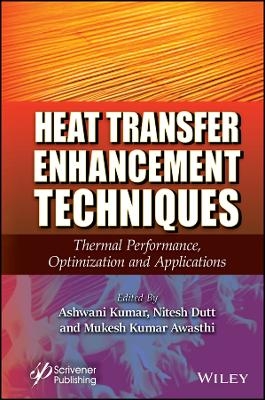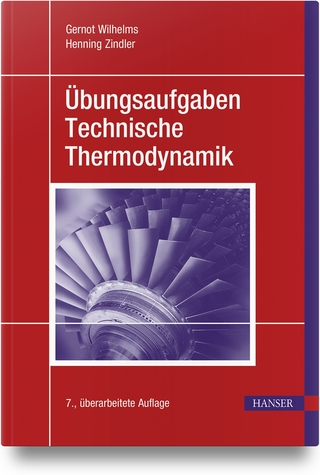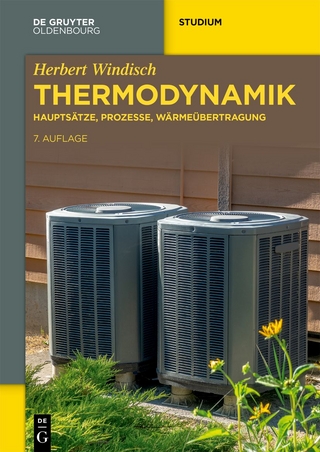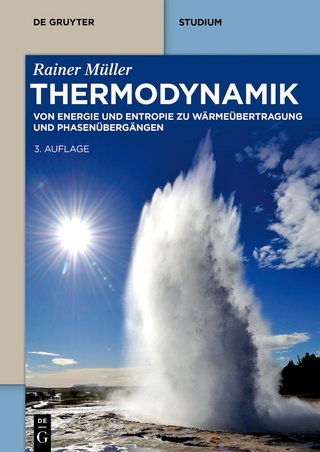
Heat Transfer Enhancement Techniques
Wiley-Scrivener (Verlag)
978-1-394-27096-5 (ISBN)
In today’s rapidly evolving world, where technological advancements are driving industries forward, the need for innovative solutions for heat transfer and dissipation challenges is becoming increasingly critical. This book serves as a comprehensive guide that explores the latest heat transfer enhancement techniques and their potential to inspire the development of new devices and technologies. By delving into this subject matter, the book aims to empower researchers, engineers, and professionals in the field with the knowledge and insights required to tackle the present and future challenges associated with heat dissipation. It provides a roadmap for pushing the boundaries of traditional thinking and fostering innovation in the field.
Heat Transfer Enhancement Techniques: Thermal Performance, Optimization and Applications will be helpful to readers in presenting the basic and advanced technological developments of heat transfer enhancement techniques. Each chapter will cover a specific problem with future scope to further extend this research. This book contains new methodologies, models, techniques, and applications, as well as fundamental knowledge of heat transfer techniques.
Ashwani Kumar, PhD is a senior lecturer teaching mechanical engineering in the Technical Education Department at Uttar Pradesh, Kanpur, India. He has more than 13 years of research, academic, and administrative experience and serves as a guest editor and editorial board member for eight international journals, as well as a review board member for 20 international journals. Being an academician and researcher, he has authored four book series, authored or co-authored over 30 books, and published over 100 research articles and two patents. Nitesh Dutt, PhD is an assistant professor in the Department of Mechanical Engineering, College of Engineering Roorkee, Uttarakhand, India. He has more than seven years of teaching experience. and has published more than 11 research articles in international journals and conferences. His main areas of research include nuclear engineering, heat and mass transfer, thermodynamics, fluid mechanics, refrigeration and air conditioning, and computational fluid dynamics. Mukesh Kumar Awasthi, PhD is an assistant professor in the Department of Mathematics at Babasaheb Bhimrao Ambedkar University, Lucknow. He has published more than 115 research publications across various mediums, including national and international journals and conferences, as well as eight books. In addition to attending many symposia, workshops, and conferences in mathematics and fluid mechanics, he has received funding for a project researching a nonlinear study of the interface in a multilayer fluid system.
Aim and Scope xvii
Preface xix
Acknowledgement xxiii
1 Recent Innovation in Heat Transfer Enhancement Techniques 1
Ashwani Kumar, Mukesh Kumar Awasthi, Nitesh Dutt and Varun Pratap Singh
1.1 Introduction 2
1.2 Important Heat Transfer Enhancement Techniques and Their Effect 7
1.3 Numerical Analysis of Heat Transfer Problem 27
1.4 Conclusion 30
References 31
2 Renewable Thermal Energy Systems: Sustainable, Modern and Reliable Energy 39
Bipasa B. Patra and Pratik Sharad Chirmade
2.1 Introduction 39
2.2 Sustainable Development Goals (SDG) 42
2.3 Discussion 54
References 56
3 HVAC System Efficiency Improvement Through Heat Transfer Enhancement Techniques 63
Md Naim Hossain and Arijit Kundu
3.1 Introduction 64
3.2 Passive Heat Transfer Enhancement Techniques 66
3.3 Electro-Passive Heat Transfer Enhancement Techniques 78
3.4 Conclusion 79
References 80
4 Indoor Thermal Performance Enhancement of Sustainable Buildings 87
D.B. Jani
List of Nomenclature 87
4.1 Introduction 88
4.2 Background of the Present Study 90
4.3 System Operation 91
4.4 Comparison of Desiccant Cooling with Traditional VCR Cooling 96
4.5 Conclusions 99
References 100
5 Eco-Friendly Paint for Sustainable Building Applications to Enhance Thermal Life Comfort 105
Vikas Chaubey, Atul Kumar, Aakash Singh and Shekhar Yadav
5.1 Introduction 106
5.2 Advantages of Vedic Plaster Over Conventional Plaster 108
5.3 Need for Vedic Paints 110
5.4 Types of Vedic Paints 112
5.5 Chemical Properties of Vedic Paints 113
5.6 Factors Increasing Comfort 114
5.7 Conclusion 116
5.8 Future Outlook 116
References 117
6 Augmentation of Solar, Geothermal, and Earth-Air Heat Exchanger in Sustainable Buildings 119
Varun Pratap Singh, Ashwani Kumar and Mukesh Kumar Awasthi
6.1 Introduction 120
6.2 Current State of Renewable Energy Technologies 121
6.3 Solar Augmentation Strategies 122
6.4 Geothermal Energy in Building Systems 128
6.5 Earth-Air Heat Exchangers: Passive and Active Cooling 135
6.6 Combined Augmentation Strategies for Sustainable Buildings 141
6.7 Conclusion 148
References 152
7 CFD Numerical Investigation of Thermal Performance of Diamond Shape Micro Rectangular Heat Exchanger 159
Jaideep, Pritosh Tomar and Ashwani Kumar
7.1 Introduction 160
7.2 Objective and Methodology 165
7.3 Parameters of Microchannel Fin Heat Sink 166
7.4 Governing Equation Used in Microchannel 168
7.5 Material Properties and Boundary Conditions 171
7.6 Result and Discussion 174
7.7 Thermal Hydraulic Efficiency of Diamond Shape Heat Exchanger Sink 186
7.8 Conclusion 187
References 187
8 Particle Swarm Optimization Technique for Determining Optimal Process Parameters for Counter Flow Double Pipe Heat Exchanger 193
Sridharan M.
Nomenclature 193
Abbreviations 194
8.1 Introduction 194
8.2 Experimental Setup 201
8.3 Mathematical Model 204
8.4 Implementation of Multi-Objective Type Optimization Technique [MOTOT] 207
8.5 Confirmation Experiments 212
8.6 Results and Discussion 212
8.7 Conclusions 217
References 218
9 Application of Geothermal Energy-Based Earth-Air Heat Exchanger in Sustainable Buildings 221
Arijit Kundu
9.1 Introduction to Sustainable Building 221
9.2 System Approach for Complex System Study 222
9.3 Earth-to-Air Heat Exchanger for Sustainable Buildings 223
9.4 EAHE Performance Evaluation: Numerical Method 227
9.5 Discussion 229
References 230
10 Numerical Study of Solar Air Heater with Semi-Cylindrical Tube Roughness 233
Ankush Hedau and S. K. Singal
Nomenclature 233
Abbreviations 234
10.1 Introduction 234
10.2 Numerical Simulation 236
10.3 Validation 241
10.4 Results and Discussions 242
10.5 Conclusions 247
Declaration of Competing Interest 248
Data Availability 248
Acknowledgement 248
References 248
11 Design and Analysis of Solar Tracking System for PV Thermal Performance Enhancement 251
Bhupender Singh, Preet Kaur, Ashok Kumar Yadav, Mukesh Kumar Awasthi and Ashwani Kumar
11.1 Introduction 252
11.2 Background and Motivation 256
11.3 Fundamentals of Arduino-Based Solar Tracking System 257
11.4 Benefits and Challenges 260
11.5 Conclusions 260
References 261
12 An Overview on Thermal Characterization of Lithium-Ion Batteries for Enhancing the Durability 269
Vikas Chaubey, Atul Kumar, Shailendra Sinha and Rakesh Verma
12.1 Introduction 270
12.2 Thermal Behavior of Li-Ion Battery 271
12.3 Heat Generation Mechanism and Thermal Modeling 272
12.4 The Effect of Temperature on Li-Ion Batteries 274
12.5 Thermal Runway Modeling and Safety Tests 276
12.6 Interior Electrode Modifications 278
12.7 Exterior Thermal Management System 279
12.8 Safety Management Strategy 280
12.9 Thermal Analysis of Lithium-Ion Batteries 283
12.10 Failures in Lithium-Ion Batteries Pack 284
12.11 Conclusion and Suggestions 286
References 287
13 An In-Depth Introduction to State of Health Estimation Methods of Li-Ion Batteries 291
Prateek Verma
13.1 Introduction 292
13.2 State of Health 293
13.3 Conclusion 305
References 306
14 Heat and Mass Transportation Enhancement of Casson Cu-AA7075-AA7072/Methanol Tri-Hybrid Nanofluid Flow Past A Porous Spinning Disk: A Computational Assessment 311
Bhagyashri Patgiri and Ashish Paul
Nomenclature 312
14.1 Introduction 313
14.2 Problem Formulation 314
14.3 Numerical Method and Validation 319
14.4 Results and Discussion 319
14.5 Conclusions 327
References 327
15 Thermal Performance of MXene (Ti 3 c 2) Nanoparticles in Blood Flow Over a Curved Region: A Biomedical Application 331
Niraj Rathore and N. Sandeep
15.1 Introduction 332
15.2 Characteristics of MXene Nanomaterials 334
15.3 Problem Description 337
15.4 Flow Nature for Different Thermal Conductivity Models 341
15.5 Outcomes and Discourse of Results 344
15.6 Conclusion 354
References 355
16 Strong Magnetic Shock Wave Propagation in a Dusty Gas 359
Akmal Husain, S. A. Haider, M. K. Shukla, Mohd Miyan and A. Taqvi
16.1 Introduction 360
16.2 Fundamental Set of Equations 362
16.3 Rankine-Hugoniot Jump Boundary Conditions for Strong Shocks 364
16.4 Closed Form Solution for Strong Shocks 366
16.5 Results and Conclusions 370
References 373
17 The Effect of Casson Fluid Flow on a Stagnation Point Over a Porous Stretching Sheet with Thermal Radiation 375
Wajeeha K., Sushma M. N., U.S. Mahabaleshwar, Mahesh R. and Dhananjay Yadav
17.1 Introduction 376
17.2 Mathematical Formulation 378
17.3 Result and Discussion 381
17.4 Conclusion 386
References 386
18 Emerging Trends in Smart Green Building Technologies 391
Gongutri Borah
18.1 Introduction 392
18.2 Environmental Challenges and the Need for Innovation 393
18.3 The Urgency for Adopting Smart Green Building Technologies 394
18.4 Innovative Architectural Designs That Prioritize Energy Efficiency 395
18.5 Passive Design Principles and Their Impact on Building Performance 397
18.6 Exploration of Eco-Friendly and Sustainable Construction Materials 398
18.7 Case Studies Showcasing the Use of Advanced Materials in Real-World Projects 399
18.8 The Intersection of IoT and Smart Green Buildings 401
18.9 Artificial Intelligence in Smart Buildings 402
18.10 The Role of Solar and Wind Energy in Achieving Net-Zero Energy Buildings 403
18.11 Energy Storage Solutions in Buildings for Balancing Intermittent Renewable Sources 404
18.12 Technologies Enhancing Occupant Well-Being and Productivity 405
18.13 The Impact of a Human-Centric Approach on Building Design 406
18.14 Smart Green Building Policies and Certifications 407
18.15 The Influence of Regulations on Industry Adoption of Smart Green Technologies 408
18.16 Speculations on the Future Trajectory of Smart Green Building Technologies 409
18.17 Conclusion: Socio-Economic Impact and Community Resilience 410
Acknowledgement 411
References 412
About the Editors 417
Index 419
| Erscheinungsdatum | 14.12.2024 |
|---|---|
| Sprache | englisch |
| Themenwelt | Naturwissenschaften ► Physik / Astronomie ► Thermodynamik |
| Technik ► Maschinenbau | |
| ISBN-10 | 1-394-27096-8 / 1394270968 |
| ISBN-13 | 978-1-394-27096-5 / 9781394270965 |
| Zustand | Neuware |
| Informationen gemäß Produktsicherheitsverordnung (GPSR) | |
| Haben Sie eine Frage zum Produkt? |
aus dem Bereich


